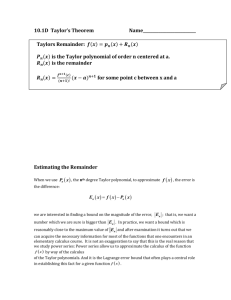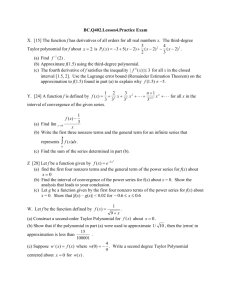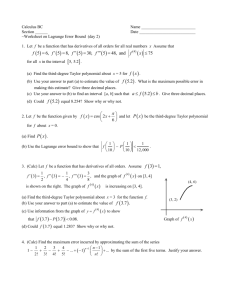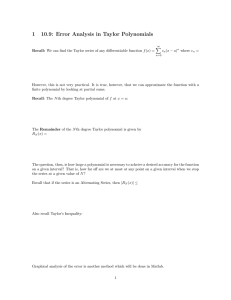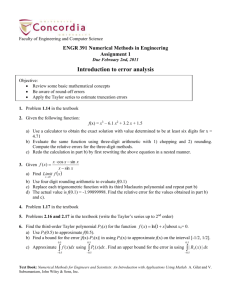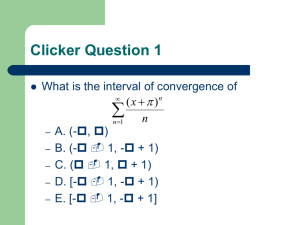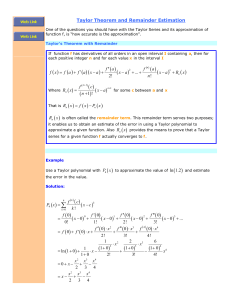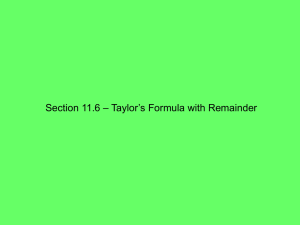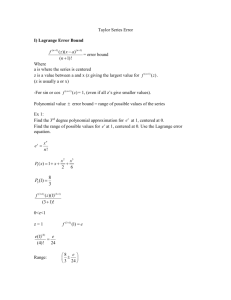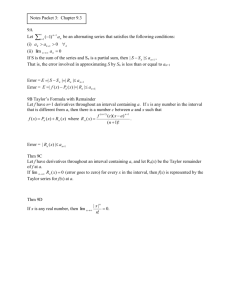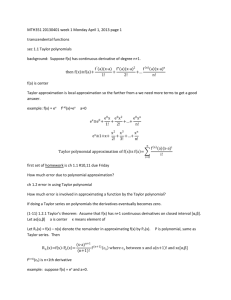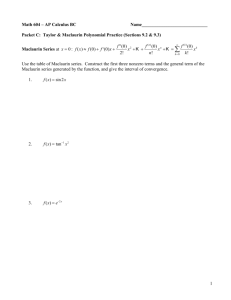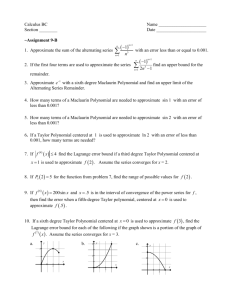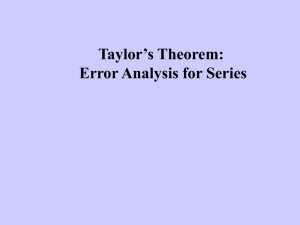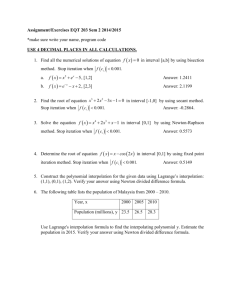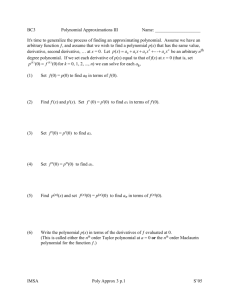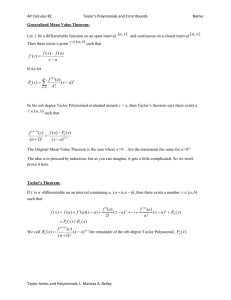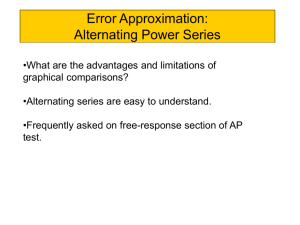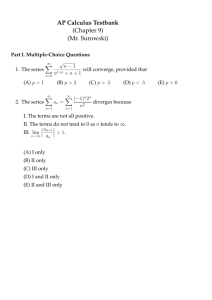10.3C The Error in Taylor Polynomials Name
advertisement
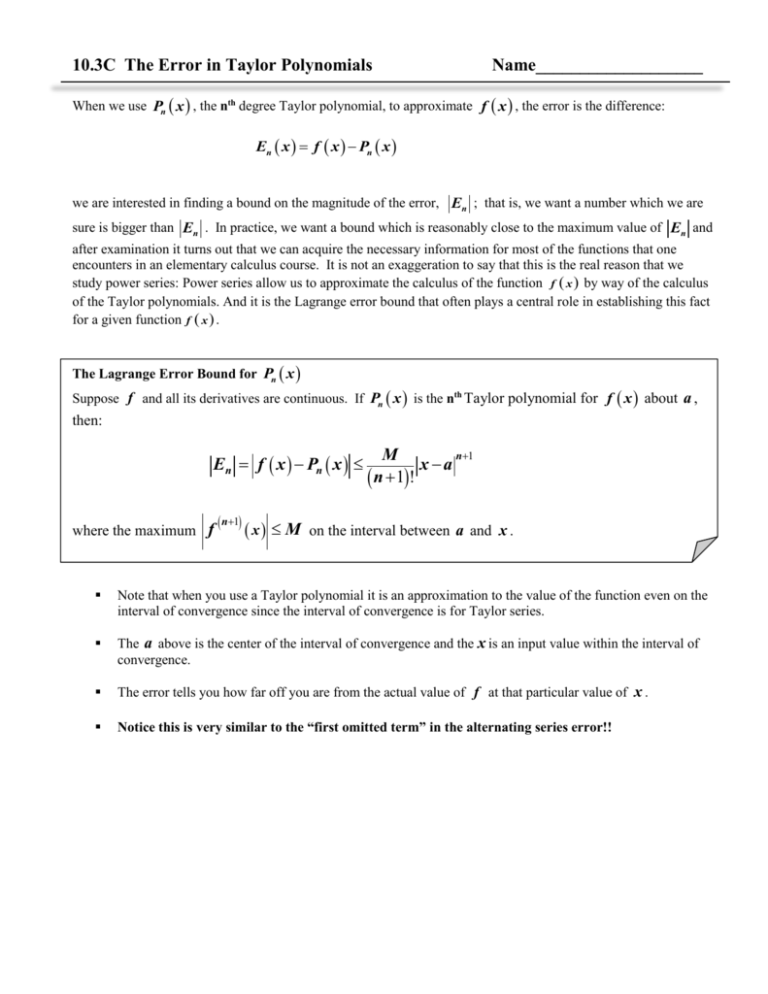
10.3C The Error in Taylor Polynomials Name___________________ When we use Pn x , the nth degree Taylor polynomial, to approximate f x , the error is the difference: En x f x Pn x we are interested in finding a bound on the magnitude of the error, En ; that is, we want a number which we are sure is bigger than En . In practice, we want a bound which is reasonably close to the maximum value of En and after examination it turns out that we can acquire the necessary information for most of the functions that one encounters in an elementary calculus course. It is not an exaggeration to say that this is the real reason that we study power series: Power series allow us to approximate the calculus of the function f x by way of the calculus of the Taylor polynomials. And it is the Lagrange error bound that often plays a central role in establishing this fact for a given function f x . The Lagrange Error Bound for Pn x Suppose f and all its derivatives are continuous. If Pn x is the nth Taylor polynomial for f x about a , then: En f x Pn x where the maximum f n1 M x a n 1! n1 x M on the interval between a and x . Note that when you use a Taylor polynomial it is an approximation to the value of the function even on the interval of convergence since the interval of convergence is for Taylor series. The a above is the center of the interval of convergence and the x is an input value within the interval of convergence. The error tells you how far off you are from the actual value of f at that particular value of x . Notice this is very similar to the “first omitted term” in the alternating series error!! Example #1 No Calculator Let f be a function having derivatives of all orders for all real numbers. The third-degree Taylor Polynomial for f about x = 2 is given by 𝑇(𝑥) = 7 − 9(𝑥 − 2)2 − 3(𝑥 − 2)3 . a. Find f(2) and 𝑓′′(𝑥). b. Is there enough information to determine whether f has a critical point at x = 2? If not, explain why not. If so, determine whether f(2) is a relative maximum, a relative minimum or neither and justify your answer. c. Use T(x) to find an approximation for f(0). Is there enough information to determine whether f has a critical point at x = 0? If not, explain why not. If so, determine whether f(0) is a relative maximum, a relative minimum or neither and justify your answer, d. The fourth derivative of f satisfies the inequality |𝑓 4 (𝑥)| ≤ 6 for all x in the closed interval [0,2]. Use Lagrange error bound on the approximation to f(0) found in part c to explain why f(0) is negative. Example #2 Use a Calculator x h(x) 𝒉′ (𝒙) 𝒉′′ (𝒙) 𝒉′′′ (𝒙) 𝒉𝟒 (𝒙) 1 11 30 42 99 18 𝟒𝟖𝟖 𝟒𝟖𝟖 𝟓𝟖𝟒 2 80 128 𝟑 𝟑 𝟗 𝟕𝟓𝟑 𝟏𝟑𝟖𝟑 𝟑𝟒𝟖𝟑 𝟏𝟏𝟐𝟓 3 317 𝟒 𝟏𝟔 𝟏𝟔 𝟐 Let h be a function having derivatives of all orders for x > 0. Selected values of h and its fist four derivatives are indicated in the table above. The function h and these four derivatives are increasing on the interval 𝟏 ≤ 𝒙 ≤ 𝟑. a. Write the first degree Taylor polynomial for h about x = 2 and use it to approximate h(1.9). Is this approximation greater than or less than h(1.9)? Explain your reasoning. b. Write the third degree Taylor polynomial for h about x = 2 and use it to approximate h(1.9). c. Use the Lagrange error bound to show that the third degree Taylor polynomial for h about x = 2 approximates h(1.9) with error less than 𝟑𝒙𝟏𝟎−𝟒 . 3. If 𝒆−.𝟏 is computed using series, then correct to three decimal places it equals? A. B. C. D. E. .905 .950 .904 .900 .949 4. If the approximate formula for 𝒔𝒊𝒏 𝒙 = 𝒙 − A. B. C. D. E. 𝒙𝟑 𝟑! is used and |𝒙| < 𝟏, then the error is less than .001 .003 .005 .008 .009 .𝟑 𝟐 5. If an approximate series is used to evaluate ∫𝟎 𝒙𝟐 𝒆−𝒙 𝒅𝒙, then correct to three decimal places, the definite integral equals A. B. C. D. E. .009 .082 .098 .008 .090

